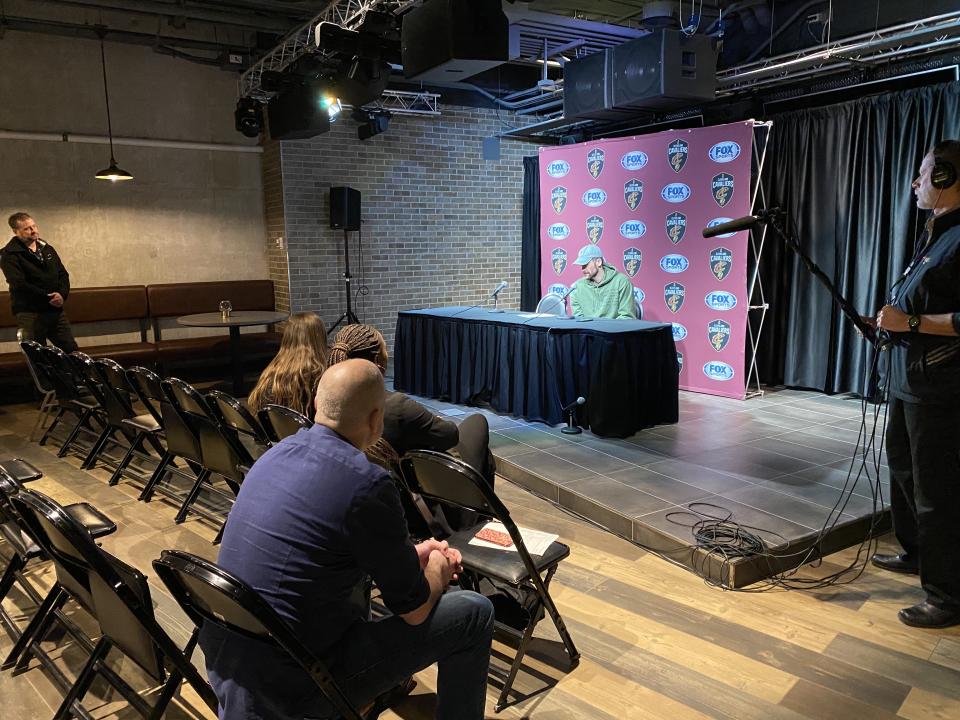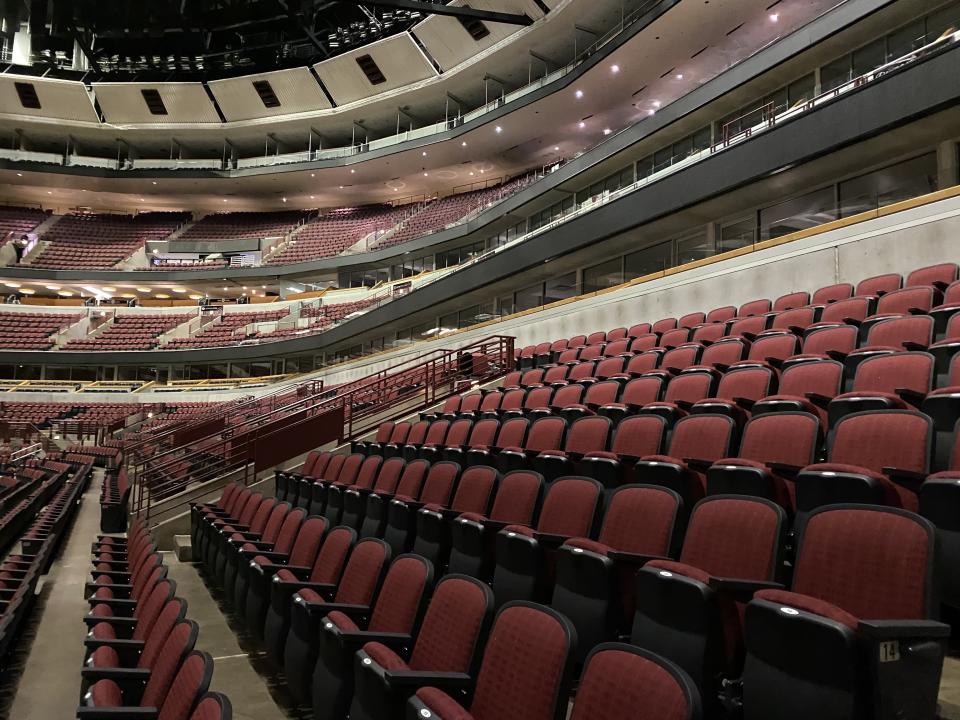An NBA grappling with coronavirus is a league full of contradictions and contrasts
CHICAGO — Jim Boylen’s United Center entrance usually begins with a fist bump. Or a “pound,” as he calls it, his knuckles to a security guard’s, on his way into work. On Tuesday, however, it didn’t.
On Tuesday, the first day of basketball in a COVID-19-fearing NBA, it instead began with a “half-elbow.” The changes continued, around two hours before tip, halfway around the arena rather than outside the Chicago Bulls’ locker room, the NBA’s new media restrictions altering his routine. Boylen sat in the dimly lit Concert Club, a dining area that had been turned into an auxiliary news conference room. He took one coronavirus-related question, then a second. Then a third, and a fourth, and a fifth, and a sixth, and a seventh. Then, finally, one about basketball.
His new starting point guard, Coby White, and injured star Zach LaVine were asked about the virus as well. They’ve had team meetings about it. They’ve talked among themselves about it. They watch the news. And some of the things they see, Boylen admitted, are “a little bit frightening.” Or “a little overpowering.”
And then there are the constant reminders. The warnings, in jest, to not touch anything. The team employees wiping down food tables, and the digital PSAs outlining best practices. Wash and scrub with soap. For 20 seconds. And don’t touch your face.
All of which explains why Chicago’s opponent, the Cleveland Cavaliers, had a “logjam in the bathroom at the sink” before breakfast on Tuesday, newly extended head coach J.B. Bickerstaff said. “You see guys with their own sanitizer,” he added. As the players trotted on and off the floor Tuesday night, none reached up to fans with open palms, only with closed fists. In the hallways, they wavered between proper bro hugs and more cautious alternatives.

But then they took the court for the 108-103 Bulls win. The virus slid back into the depths of their minds. Up above, fans filtered in, largely unconcerned. They used the same water fountains they always do. Pulled the same ketchup levers. Exchanged the same dollar bills with beer vendors. Shared the same chicken finger baskets. Socialized at the same concessions tables. Listened to the same in-game music, and enjoyed the same arena entertainment, and watched the same basketball.
The NBA’s public-facing product on Tuesday night emerged in stark contrast to the concern unfolding around it. The question is, “Why?” And whether that’s acceptable. And how long semi-normalcy will last.
The NBA’s contradictory coronavirus stance
Around the time the United Center’s doors opened on Tuesday evening, so, seemingly, did the sports world’s reactionary floodgates. As fans in Chicago roamed the concourse, two college basketball conferences announced that their postseason tournaments would be played without any. The Ivy League had outright canceled theirs. Ohio governor Mike DeWine recommended a ban on spectators at indoor events. Washington governor Jay Inslee is expected to announce similar measures.
And the NBA?
Media access was the first thing to go. As of Wednesday morning, it remains the only thing. Which is telling.
“I found it quite curious,” California governor Gavin Newsom said Tuesday, “that the four major organizations – NHL, soccer, Major League Baseball and the NBA – put out guidelines to protect their athletes but not their fans.”
Experts, to be sure, are largely in agreement about the need for social distancing. “We would recommend that there not be large crowds,” Dr. Anthony Fauci, the nation’s top public health official, said Wednesday. “If that means not having any people in the audience when the NBA plays, so be it.”
But the NBA is a billion-dollar corporation. Billion-dollar corporations, for the most part, do not exist to serve a greater good. They serve themselves. They provide products or private services or entertainment, but are beholden to their bottom lines. The NBA is no different, which explains why it moved quickly to shelter its highest-paid employees, the reasons fans fill seats, but has moved lethargically – or negligently – to protect those fans. It often claims to care about them. About you. What it really cares about are your dollars.

And what became clear Tuesday night, both in conversations with fans and observation, is that they are perfectly willing to continue to spend those dollars if the NBA allows them to. Barring fans would cost teams millions. They’re not inclined to voluntarily forfeit cash. Their actions, viewed alongside their media policy, seem contradictory. The contradiction also makes complete sense.
The vexing question, then, is whether the NBA has a responsibility to the public well-being that transcends its private financial interests. Its games may contribute to the spread of the virus, and eventually even to death – even if the at-risk individual who suffers is two or three degrees removed from the 25-year-old fan who contracts the virus at a game. Does the NBA have a responsibility to put that at-risk individual above the thousands of unconcerned, low-risk 20-somethings who’ll pay to enjoy weeknight basketball?
Your answer to that question is entirely subjective. The real answer is that the decision should be taken out of a billion-dollar corporation’s hands. In Italy, it was the government that enforced stadium closures, and ultimately shut down soccer for a month. In the U.S., that appears to be the next step.
Basketball without fans? ‘It’s coming’
Back inside that dimly lit auxiliary media room, we waited. The Bulls had beaten the Cavaliers. At 9:43 p.m., Bickerstaff had wrapped up his postgame news conference. At 10, with the locker room completely off limits, still, we waited for our first interview with a Cavs player. We eventually got two. Makeshift accommodations were sufficient. Public relations staffs were helpful. Access, however, was and will be fundamentally altered.
The game, however, had not been. There were some empty seats, as there would be for any March game between directionless lottery teams. But 17,837 attended. They cheered. They chatted. They ignored intangible risk. They enjoyed the show.
What will stop them are precautionary measures like the one Santa Clara Country announced on Monday, when it outlawed public gatherings of more than 1,000 people for a month. Like the ones that San Francisco County is recommending, but that the Golden State Warriors have resisted. Like the ones DeWine, the Ohio governor, is asking for — ones that would force the Cavs, the same Cavs who played in front of 17,837 on Tuesday night, to play in front of nobody.
With the media room all but cleared out, I mentioned the possibility of spectator-less games to Kevin Love. Before I could ask a question, he interjected.
“It’s coming,” Love said. “It’s coming.”
It has forced players, coaches, people at all levels of the NBA to consider what hoops without hoop heads would be. What it would look like. What it would sound like. What it would feel like.
“A lot of what we do is based on the emotion and the energy that the fans bring,” Bickerstaff said. “There’s moments in games where you’re down, and you’re at home, and your crowd gives you that boost, gives you that energy, and you start to feed off that. … But now figuring out, how do you do that looking around at an empty stadium? It’ll be tough. It’ll be awkward at the beginning.”
Most of all, it’ll be different. The Cavs and Bulls players who spoke Tuesday night racked their brains for a precedent. The closest White could come to a similar experience was pickup runs at the Y.
“I couldn’t even fathom or conceptualize what that would even feel like,” Love said. “Obviously, I’ve been in empty arenas going through five-on-five scrimmages [in practice]. But even in college, we used to put the faux crowd noise on, and it’d be super loud.”
Without the artificial noise, he concluded, “I can’t even put into words what that would be like.”

More from Yahoo Sports:



